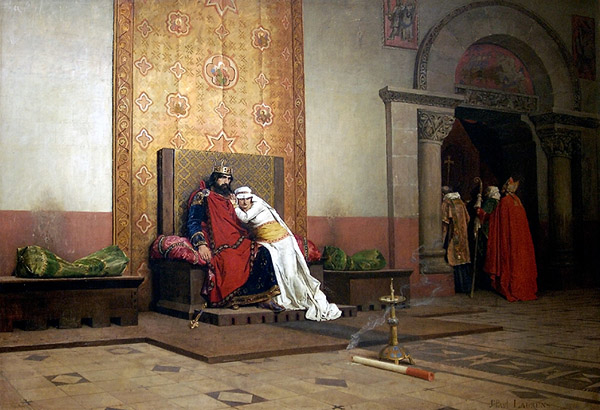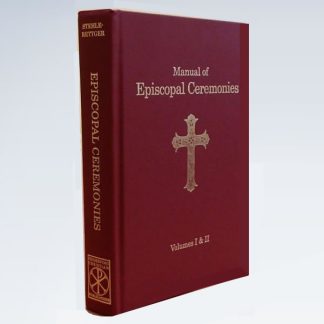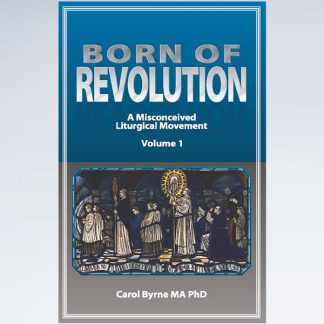

painting by Jean-Paul Laurens
License: Courtesy of Wikimedia Commons
Since the time of the apostles, the term ‘anathema’ has come to mean a form of extreme religious sanction, known as excommunication.
The phrase “bell, book, and candle” refers to a Latin Christian method of excommunication by anathema, imposed on a person who had committed an exceptionally grievous sin. Evidently introduced by Pope Zachary around the middle of the 8th century, the rite is used by the Roman Catholic Church.
Anathema is not final damnation. God alone is the judge of the living and the dead, and up until the moment of death repentance is always possible. The purpose of public anathema is twofold: to warn the one condemned and bring about his repentance, and to warn others away from his error. Everything is done for the purpose of the salvation of souls.
The Ritual
The ceremony is described in the Pontificale Romanum, the last edition of the Tridentine Rite published before Vatican II.
The ceremony traditionally involved a bishop, with 12 priests bearing candles, and would solemnly be pronounced in some suitably conspicuous place. The bishop would then pronounce the formula of the anathema, which ends with the following words:
| Idcirco eum cum universis complicibus, fautoribusque suis, judicio Dei omnipotentis Patris, et Filii, et Spiritus Sancti, et beati Petri principis Apostolorum, et omnium Sanctorum, necnon et mediocritatis nostrae auctoritate, et potestate ligandi et solvendi in coelo et in terra nobis divinitus collata, a pretiosi Corporis et Sanguinis Domini perceptione, et a societate omnium Christianorum separamus, et a liminibus sanctae matris Ecclesiae in coelo et in terra excludimus, et excommunicatum et anathematizatum esse decernimus; et damnatum cum diabolo, et angelis ejus, et omnibus reprobis in ignem aeternum judicamus; donec a diaboli laqueis resipiscat, et ad emendationem, et poenitentiam redeat, et Ecclesiae Dei, quam laesit, satisfaciat, tradentes eum satanae in interitum carnis, ut spiritus ejus salvus fiat in die judicii.[2] | Wherefore in the name of God the All-powerful, Father, Son, and Holy Ghost, of the Blessed Peter, Prince of the Apostles, and of all the saints, in virtue of the power which has been given us of binding and loosing in Heaven and on earth, we deprive him and all his accomplices and all his abettors of the Communion of the Body and Blood of Our Lord, we separate him from the society of all Christians, we exclude him from the bosom of our Holy Mother the Church in Heaven and on earth, we declare him excommunicated and anathematized and we judge him condemned to eternal fire with Satan and his angels and all the reprobate, so long as he will not burst the fetters of the demon, do penance and satisfy the Church; we deliver him to Satan to mortify his body, that his soul may be saved on the day of judgment.[1] |
After this recitation the priests would respond: “Fiat, fiat, fiat” (“So be it! So be it! So be it!”).
The bishop would then ring a bell, close a Holy Book, and he and the assisting priests would snuff out their candles by dashing them to the ground. However, the rite of anathema as described in the Pontificale Romanum only prescribes that the candles be dashed to the ground.
After the ritual, written notices would be sent to the neighbouring bishops and priests to report that the target had been anathematized and why, so that they and their constituents would hold no communication with the target. [2]
The frightful pronouncements of the ritual were calculated so as to strike terror into the ones so excommunicated and bring them to repentance.
References
- “Ordo Excommunicandi et Absolvendi”. Liturgia Latina. Retrieved July 25, 2014.
- Joseph Gignac, “Anathema” in Catholic Encyclopedia (New York 1907)
- Lea, Henry C.: Studies in Church History: The Rise of the Temporal Power, pp. 339ff, Sampson Low, Son, & Marston, 1869.
For information on many cases of liturgical abuse within the Catholic church, including cases of high-profile Catholic clerics involved in illicit sexual relations, false prophets, thieves, heretical fraudsters and schismatics who infiltrated the Holy Catholic Church and its establishments, visit Vox Cantoris and its network of the traditional Catholic websites.
Ordo Excommunicandi et Absolvendi

VIRGÓ SACRÁTA is a Christian mission-driven online resource and shop inspired from the beauty of Catholic faith, tradition, and arts. Our mission is to “Restore All Things to Christ!”, in continuing the legacy of Pope St. Pius X under the patronage of the Blessed Virgin Mary. “Who is she that cometh forth as the morning rising, fair as the moon, bright as the sun, terrible as an army set in battle array?” O Mary, conceived without sin, pray for us who have recourse to Thee.





